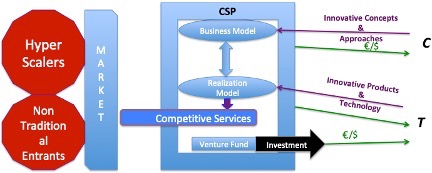Building an Innovation Ecosystem

Among thought leaders in the telco industry, the need for a sustainable innovation ecosystem is now clear. With the advance of the super scalers and the new LEOSat (Low Earth Orbiting Satellite) entrants in the wings, traditional Communication Service Providers (CSPs) face a tremendous challenge. Not responding to the challenge will dramatically reduce revenues and possibly challenge their very existence. To compound the situation, the existing large vendor ecosystem selling to the CSPs is in the same boat. All are faced with a fundamental need to change to survive.
The path to success for CSP’s is to feed and nurture—with funding and support—a pipeline of innovative projects. These can come from startups and combinations of startups and skunk works in the large vendors, and they will deliver the stream of innovation so desperately needed.
Understanding the challenge
The super scalers have been experimenting with providing end-to-end services, including the underlying communications infrastructure. They have undertaken this while they and new entrants are preparing LEOSat-based services.
One of the most promising is Goggle Fi. This is Google’s MVNO (Mobile Virtual Network Operator). It contracts with three CSPs and adds capability to select, combine, and enhance services delivered to Google-branded phones. The customers don’t know who the underlying CSPs and phone manufacturers are. All they know is that they are getting a superior service at very good prices, especially for international coverage. This means that Google can seamlessly insert its own communication service when it has it available.
Google and many others are also working on LEOSat systems. These are based on a fundamental change in the economics of satellites. With the advent of lower-cost launches from commercial rocket companies, combined with multiple shoebox-sized basestations in a single orbital payload, many new entrants are betting that they can deploy a low-cost, high-quality competitor to cellular. Google is in the advantageous position of already having a customer base that it can move seamlessly onto its own facilities as they become available.
And this wave of new entrants is not the last. The pace of technology innovation is accelerating, and although we can’t predict the successive waves, we know they are coming.
The response
To remain healthy and viable in this environment, CSPs need to be able to deliver both traditional services at better quality and pricing with new innovative services. This can only come through innovation. And the existing large vendor ecosystem is not well-suited to deliver the needed innovation. The question becomes: how do CSPs create a vendor ecosystem that provides them the innovative technology and products they so desperately need?
In previous articles, we have discussed the role of software and how innovation in this area comes from small groups. To create and maintain an ecosystem of these small innovative groups, CSPs need to provide financial support processes that foster them. This needs to be from both the core of the CSP and its Venture Capital (VC) arm.

Figure 1. Innovation Critical to Respond to Heightened Competition
The funding from the core of the CSP needs to be task- or project-based. The tasks are around early paper studies that define the concept, analyze potential benefits, discuss financial feasibility, develop plans for possible demonstrations, and define success criteria. Projects focus on paid demonstrations.



















